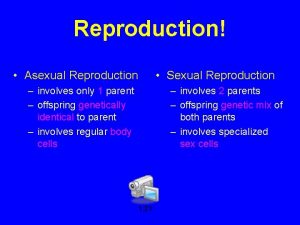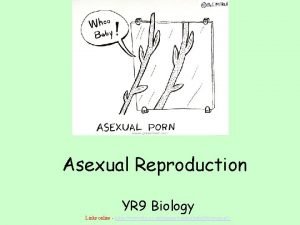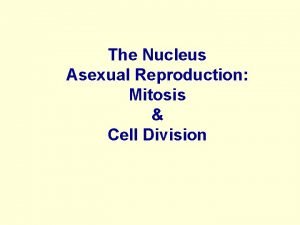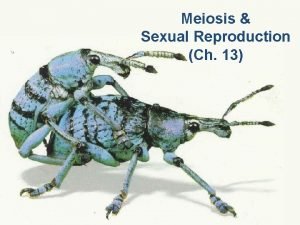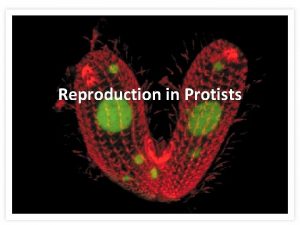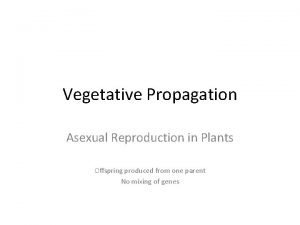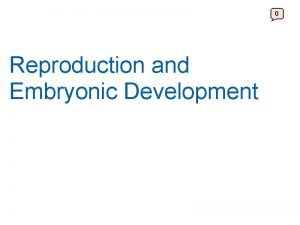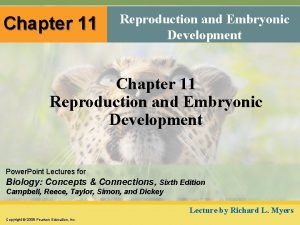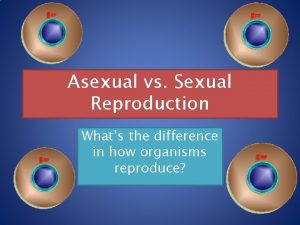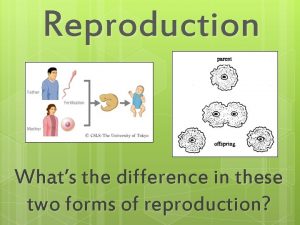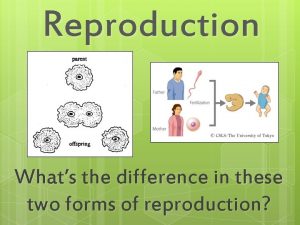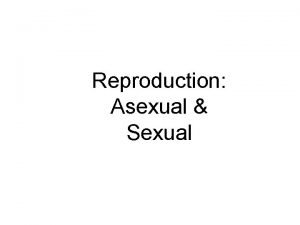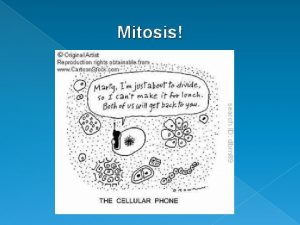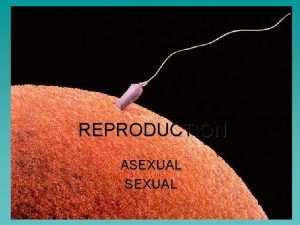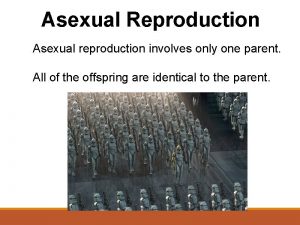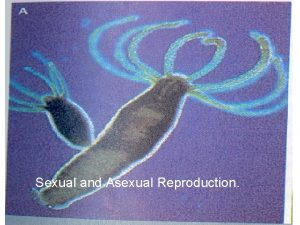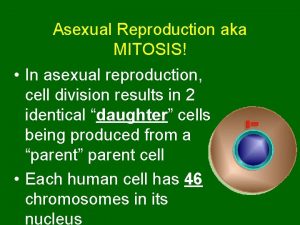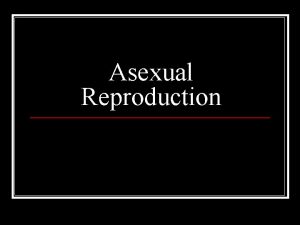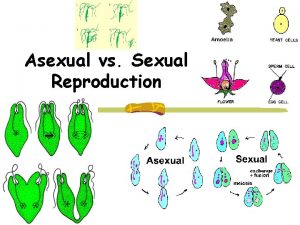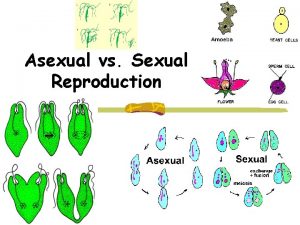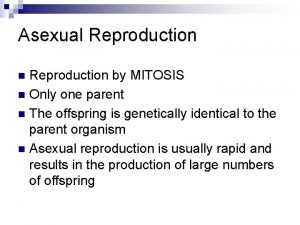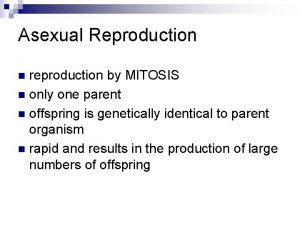Asexual Reproduction Mitosis Asexual Reproduction Definition one parent
























- Slides: 24

Asexual Reproduction & Mitosis

Asexual Reproduction • Definition: one parent produces genetically identical offspring • Advantages: – Can produce offspring w/o a mate – Many offspring in short time • Disadvantages: – No variation in offspring – No adaptation to new/changing environments

Asexual Reproduction What kinds/types of reproduction are asexual? 1. Budding - a new individual grows on a ‘parent’ Example: hydra, yeast

Asexual Reproduction What kinds of reproduction are asexual? 2. Binary Fission - a ‘parent individual’ splits into two independent organisms Example: bacteria

Asexual Reproduction What kinds of reproduction are asexual? 3. Regeneration - fragments of the ‘parent’ can grow into new organisms Example: starfish, planarian

Asexual Reproduction What kinds of reproduction are asexual? 4. Parthenogenesis - production of offspring from unfertilized eggs

Asexual Reproduction What kinds of reproduction are asexual? 5. Vegetative reproduction - occurs in plants New plants rise w/o the production of seeds or spores

Mitosis • Makes two cells that are genetically identical to each other • Purpose? – growth and repair

Chromosomes -Passed on from one generation to the next -Genetic material composed of genes which are made up of DNA – Only visible during cell division – Found in the nucleus – Condensed DNA

How DNA forms chromosomes

Chromatin • Chromatin – uncondensed DNA; appears very “stringy” – Form of DNA between cell divisions

Parts of a Chromosome • Sister chromatids: identical copies of a chromosome – Made during the S phase of the cell cycle • Centromere: holds two sister chromatids together

The Cell Cycle

The Cell Cycle • Interphase: – G 1 phase: cell growth – S phase: DNA is replicated/copied – G 2 phase: more cell growth • Mitotic Phase: – Mitosis/Cell Division – Cytokinesis (division of cytoplasm)

Mitosis Prophase Anaphase Metaphase Telophase

Prophase of Mitosis • Chromatin coils up into visible chromosomes • Centrioles migrate to opposite ends • Nuclear envelope and nucleolus break down • Centromere of chromosome starts to attach to spindle fibers

Metaphase of Mitosis • Chromosomes line up in the middle of the cell

Anaphase of Mitosis • Spindle fibers contract (shorten) • Chromosomes are pulled apart • Sister chromatids move to opposite poles

Telophase of Mitosis • Chromosomes gather at opposite poles • Nuclear envelope starts to reform

Cytokinesis • Division of the cytoplasm – Plant Cells: cell plate is formed → cell wall – Animal Cells: cleavage furrow formed

Summary of Mitosis • Start with 1 parent cell and ends with 2 daughter cells • 2 daughter cells are formed that are genetically identical to the parent cell • Occurs in somatic cells (aka, body cells) • Functions in growth and repair of cells

Virtual Animation of Mitosis • Check out this site: Virtual Mitosis Animation

Cell Cycle Regulation • Cyclin – a group of proteins that regulates the timing of the cell cycle – Controls when cells go from G 1 to S phase – Controls when cells go from S to G 2 phase – Controls when cells go from G 2 to M phase

Uncontrolled Cell Growth • Cancer – abnormally rapid cell division • Cells of the tumor may break lose and spread or metastasize through the body • May be caused by radiation, pollution, bad luck, viral exposure • Many cancer cells have a mutation/defect in gene p 53 (gene that normally tells the cell to wait until all chromosomes have been replicated before proceeding to mitosis)
 Sexual reproduction vs asexual reproduction venn diagram
Sexual reproduction vs asexual reproduction venn diagram Hare lynx
Hare lynx Sexual and asexual reproduction in animals venn diagram
Sexual and asexual reproduction in animals venn diagram What type of reproduction involves only one parent
What type of reproduction involves only one parent Runner plants examples
Runner plants examples Is mitosis asexual
Is mitosis asexual Primary oocyte haploid or diploid
Primary oocyte haploid or diploid Asexual reproduction cell division
Asexual reproduction cell division Asexual reproduction in protists
Asexual reproduction in protists Vegetative propagation
Vegetative propagation Fission vs budding
Fission vs budding Labelled diagram of platyhelminthes
Labelled diagram of platyhelminthes Parthenogenesis
Parthenogenesis Example of asexual
Example of asexual Layering asexual reproduction
Layering asexual reproduction Types of asexual reproduction
Types of asexual reproduction Asexual reproduction
Asexual reproduction Gastrula
Gastrula Whats sexual reproduction
Whats sexual reproduction Examples of sexual reproduction
Examples of sexual reproduction Chapter 19 asexual reproduction
Chapter 19 asexual reproduction Difference of sexual and asexual reproduction
Difference of sexual and asexual reproduction What is reproduction
What is reproduction Whats reproduction
Whats reproduction Sexual reproduction
Sexual reproduction



